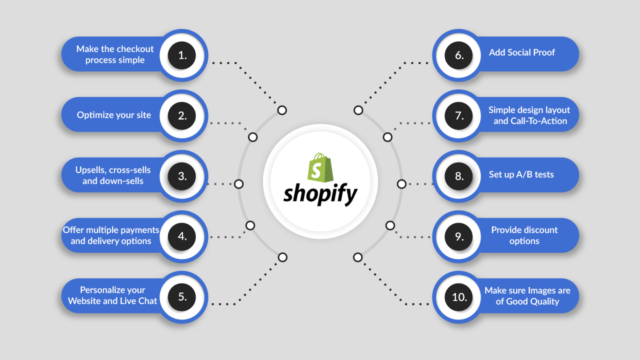In the competitive landscape of e-commerce, Shopify has emerged as a prominent platform for entrepreneurs to showcase their products and reach a global audience. To maximize sales potential, Shopify store owners must ensure that their online storefronts are optimized effectively. Here are ten essential tips to achieve this goal:
- Streamline Navigation and User ExperienceNavigation and user experience are critical factors that influence customer retention and conversion rates. Ensure that your Shopify store is designed with intuitive navigation, allowing visitors to easily find products and navigate through categories without confusion.Example: Products should be categorized logically, and a search function should be prominently displayed to assist users in finding specific items.
- Optimize Page Loading SpeedPage loading speed significantly impacts user satisfaction and SEO rankings. Ensure that your Shopify store is optimized for speed by minimizing unnecessary scripts, compressing images, and leveraging browser caching.Example: Images should be resized and compressed without compromising quality to reduce loading times, enhancing the overall browsing experience.
- Implement Responsive DesignWith the increasing use of mobile devices for online shopping, it is crucial to implement a responsive design for your Shopify store. Ensure that your store adapts seamlessly to various screen sizes and devices.Example: Mobile users should experience the same ease of navigation and functionality as desktop users, facilitating a consistent shopping experience across all platforms.
- Use High-Quality Visuals and Product DescriptionsVisual appeal plays a significant role in influencing purchasing decisions. Use high-quality images and videos to showcase your products effectively. Ensure that product descriptions are informative and persuasive, highlighting key features and benefits.Example: Each product listing should include multiple high-resolution images from different angles and a detailed description that addresses customer needs and preferences.
- Optimize SEO ElementsEnhancing your Shopify store’s visibility on search engines is essential for driving organic traffic. Optimize SEO elements such as meta titles, descriptions, headers, and alt texts to improve search engine rankings and attract qualified leads.Example: Each product page should have a unique meta title and description that incorporates relevant keywords and appeals to both search engines and potential customers.
- Offer Multiple Payment OptionsProviding multiple payment options enhances convenience and encourages customers to complete their purchases. Integrate popular payment gateways and ensure that the checkout process is streamlined and secure.Example: Customers should have the option to pay via credit/debit cards, digital wallets, and other preferred payment methods, minimizing barriers to completing transactions.
- Enable Customer Reviews and TestimonialsSocial proof significantly influences purchasing decisions. Enable customer reviews and testimonials on your Shopify store to build trust and credibility among potential buyers. Encourage satisfied customers to leave feedback and showcase positive reviews prominently.Example: Product pages should prominently display customer reviews and ratings, allowing visitors to make informed purchasing decisions based on peer feedback.
- Implement Abandoned Cart Recovery StrategiesCart abandonment is a common challenge in e-commerce. Implement automated email reminders and incentives to recover abandoned carts and encourage customers to complete their purchases.Example: A series of personalized emails can be sent to customers who abandon their carts, offering discounts or reminding them of the benefits of the products left behind.
- Utilize Upselling and Cross-Selling TechniquesIncrease average order value by implementing upselling and cross-selling techniques on your Shopify store. Recommend related products or upgrades based on customer preferences and purchase history during the checkout process.Example: On the checkout page, suggest complementary products or upgrades that enhance the value or functionality of items already in the customer’s cart, increasing the likelihood of additional purchases.
- Monitor and Analyze Performance MetricsContinuous monitoring and analysis of performance metrics are crucial for optimizing your Shopify store’s sales potential. Use analytics tools to track visitor behavior, conversion rates, and sales trends. Identify areas for improvement and implement data-driven strategies to enhance overall performance.
- Example: Regularly review key metrics such as bounce rate, conversion rate, average order value, and customer acquisition cost to gauge the effectiveness of your optimization efforts and make informed decisions for future improvements.










